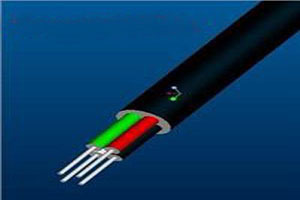What are the cables used on ships and offshore platforms? The following is an introduction to the types of power cables used on ships and offshore platforms.
1. Purpose:
This type of cable is suitable for power transmission in power systems with AC rated voltage of 0.6/1KV and below on various river and sea ships, offshore oil and other water structures.
2. Reference standard:
IEC60092-353 1KV~3KV and below extruded solid insulation marine power cables
3. Use features:
Working temperature: 90℃, 125℃, etc.
Rated voltage U0/U: 0.6/1KV
Minimum bending radius: not less than 6 times the outer diameter of the cable
The service life of the cable is not less than 25 years.
4. Performance indicators:
The DC resistance of the conductor at 20°C meets the IEC60228 standard (GB3956).
The insulation resistance of the cable at 20°C is not less than 5000MΩ·km (much higher than the performance index of the insulation resistance constant required by the IEC60092-353 standard).
The flame retardant performance meets the requirements of IEC60332-3-22 Class A flame retardant (fire for 40 minutes, and the carbonization height of the cable does not exceed 2.5m).
For fire-resistant cables, their fire-resistant performance meets IEC60331 (90 minutes (fire supply) + 15 minutes (after fire removal), flame temperature 750 ℃ (0 ~ +50 ℃) cable power supply is normal, no electricity).
The low-smoke halogen-free index of the cable meets the requirements of IEC60754.2, the halogen acid gas release is not more than 5mg/g, the specific detection of its pH value is not less than 4.3, and the conductivity is not more than 10μs/mm.
Low smoke performance of the cable: The smoke density (light transmittance) of the cable is not less than 60%. Meet the standard requirements of IEC61034.
5. Cable structure
The conductor is made of high quality annealed tinned copper. This type of conductor has a very good anti-corrosion effect. The conductor structure is divided into solid conductors, stranded conductors and soft conductors.
The insulation adopts extruded insulation. This extrusion method can reduce the gas between the conductor and the insulation to prevent the entry of impurities such as water vapor.
The color code is generally distinguished by color. Colors can be selected and processed according to site needs for easy installation.
The inner sheath/liner (Jacket) is a low-smoke halogen-free material with high flame retardancy. The material is halogen free.
The armor layer (Armor) is a braided type. This type of armor has better flexibility and is convenient for cable laying. Braided armor materials include tinned copper wire and galvanized steel wire, both of which have good anti-corrosion effect.
The outer sheath (Sheath) material is also low-smoke halogen-free material. This produces no toxic gas when burning and produces little smoke. It is used more in crowded places.
The identification of the cable can be printed according to actual needs.
6. Cable model:
1. XLPE insulated low-smoke halogen-free outer sheathed cable model:
CJEW/SC, CJEW/NC, CJEW95(85)/SC, CJEW95(85)/NC,
2. EPR insulated low-smoke halogen-free outer sheathed cable model:
CEEW/SC, CEEW/NC, CEEW95(85)/SC, CEEW95(85)/NC,
3. Model description:
C- means marine power cable
J-XLPE insulation
E-EPR (Ethylene Propylene Rubber Insulation)
EW-low smoke halogen free polyolefin sheath
95- Galvanized steel wire braided armor and LSZH outer sheath (braid density not less than 84%)
85 – Tinned copper wire braided armor and LSZH outer sheath (braid density not less than 84%)
The flame retardant performance of SC-cable meets IEC60332-3-22 Class A flame retardant, and the halogen content is less than 5mg/g
NC – The fire resistance of the cable meets IEC60331, and the halogen content is less than 5mg/g
Post time: Mar-18-2022

